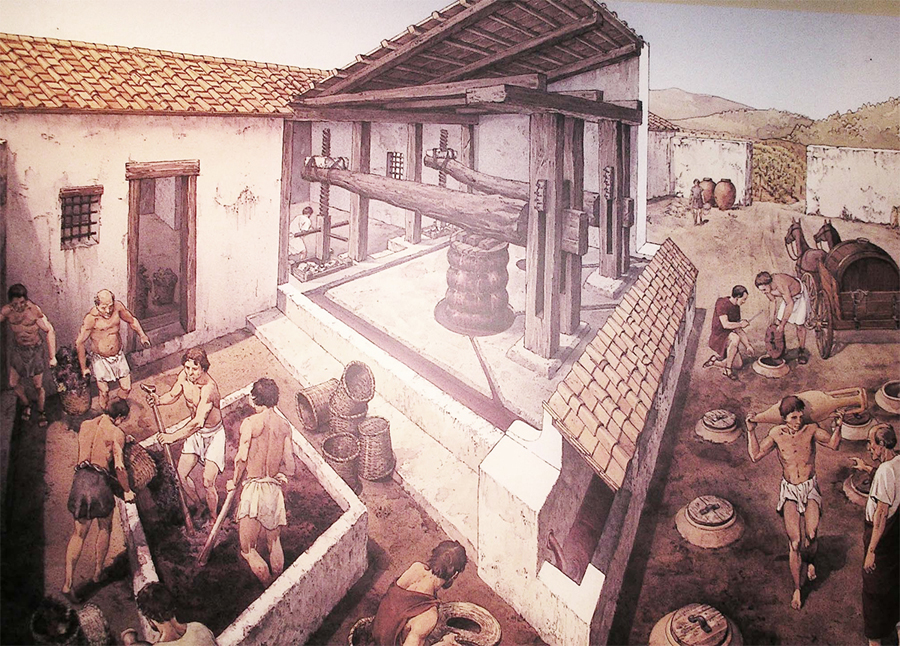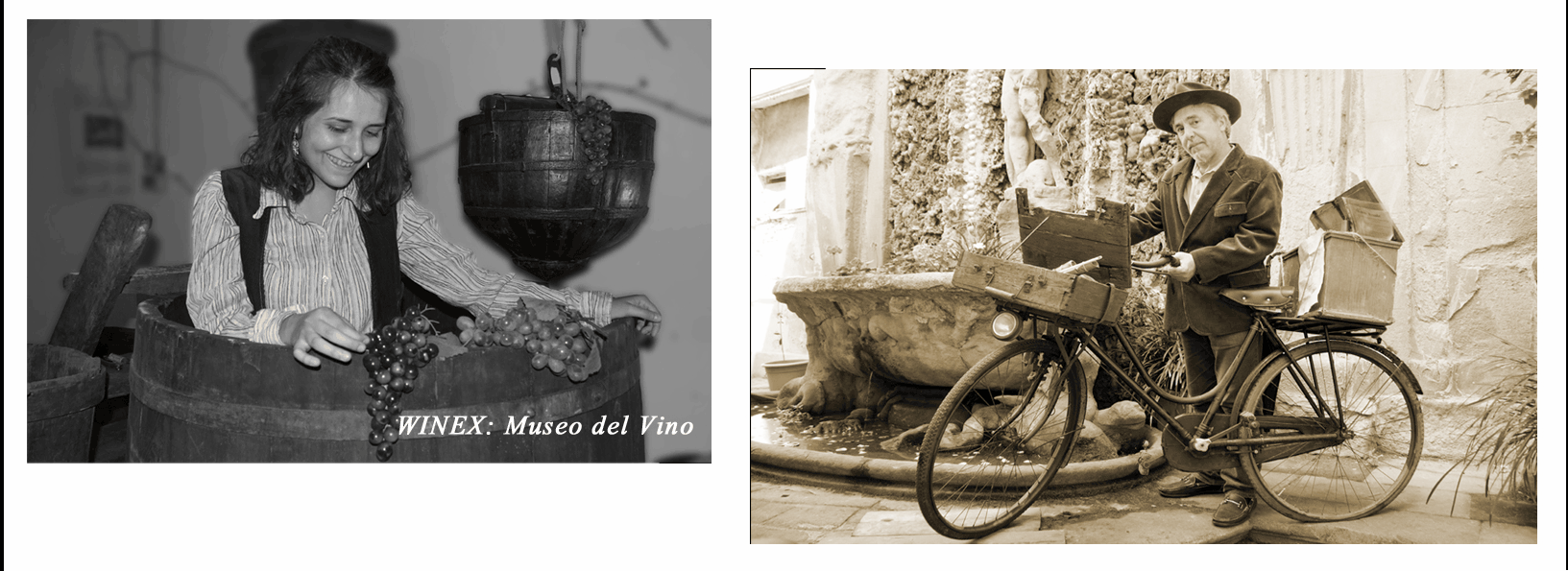ALLE ORIGINI DEL VINO
|
ATTREZZATURE PER LA
VINIFICAZIONE
Per
produrre
il vino
è necessaria un'attrezzatura
minima
che prima consenta
di pigiare
i grappoli
per
farne
uscire il succo e,
successivamente,
di
spremere
i
resti
della
pigiatura
per estrarne
la parte liquida
residua,
ancora
abbondante.
Gli
strumenti per compiere
le due operazioni
possono essere
elementari,
ma
già
nell'antichità
si sono perfezionati
fino
a raggiungere
un
grado
di
efficacia
tale da non richiedere
poi significativi
mutamenti
fino
al
secolo scorso.
Nell'età
del
Bronzo la
spremitura dell'uva
era effettuata pigiando con i
piedi
i grappoli
all'interna
di una vasca che poteva
essere scavata nella
roccia,
come
accadeva in Palestina,
o
in
tinozze
di ceramica provviste
di
un
versatoio,
dal
quale il
mosto
cadeva in un orcio,
come si vede in diversi impianti
produttivi
scavati a Creta. Anche in Grecia c'erano pigiatoi
di
ceramica
e di
pietra
dove
si
pestava
l'uva,
ma
in epoca arcaica
accanto a
questi si usavano altri strumenti di
legna,
facilmente
trasportabili,
che
erano impiegati
nel vigneto,
come
mostrano
alcune scene
riprodotte su vasi attici
a
figure nere
e a figure rosse
del VI e del V secolo a.C.
Questo
genere di pigiatoio di legno era
costituito
da una superficie piana,
un
disco,
forse con una bassa parete o una canaletta
lunga il margine per
convogliare
il
mosto
al versatoio.
Questa
base era sollevata
da terra per mezzo
di alte
zampe e il liquido colava in
un grosso contenitore pasto sotto il versatoio.
Sul disco di legno sembra
che fosse appoggiata
una sorta di cesta
provvista
di manici
che
conteneva uva o vinacce già
pigiate altrove,
come
sembra suggerire
la scena su un cratere attico a
figure rosse
dalla Puglia. Qui
un gruppo
di satiri
è
intento a vinificare:
sulla
destra
uno pigia
l'uva
dentro
a una vasca dalle
pareti abbastanza alte,
sostenendosi
a
due lacci
che pendono dall'alto;
in
mezzo
al quadro un altro
satiro
schiaccia con i piedi
una
cesta a un sacco provvisto di
due
prese,
forse
contenente vinacce,
appoggiato
sopra al pigiatoio di
legno
di cui sono evidenti
i
chiodi
che
fissano
le zampe;
dal
versatoio
il
mosto
cola
abbondante in un contenitore
del quale si occupa il terzo
satiro,
che
parta un catino
forse per sostituire quello
riempito di mosto.
Il
cratere
attico a figure
rosse in
mostra
presenta una
scena di
spremitura
presieduta da Dioniso
dove un satiro utilizza
lo stesso pigiatoio di legno sul quale è poggiata
ancora una cesta con maniglia
ben in vista.
Un
particolare pigiatoio di terracotta è stato trovato
nella fattoria
etrusca
di Poggio Bacherina,
nell'agro
di Chiusi, distrutta
da un incendio
agli inizi
del I secolo a.C. Il
contenitore ha la forma somigliante a
una grossa scarpa,
con
una larga
imboccatura (cm 50 ca.)
e una breve punta,
forata
nella parte inferiore per far calare
il mosto.
In
una stanza vicina al pigiatoio, erano stivati
quindici
orci,
all'interna
di molti dei quali rimanevano numerosi
vinaccioli
a indicare il contenuto. In età
imperiale, quando ormai i pigiatoi sono costruiti
in muratura,
la forma
dei
sarcofagi
a vasca,
largamente
impiegati,
richiama
ancora la tinozza
con profila svasato, spesso provvista
di colatoi,
tradizionalmente
usata per pigiare
l'uva.
Sono
le
stesse
scene di vendemmia raffigurate su alcuni sarcofagi che ne illustrano la
funzione: i pigiatoi hanno per lo più forma ovale e, talora, protomi di
leone a
fauci aperte donde il mosto cola in altri vasi.
Scarse
sono le testimonianze sull'uso di torchi da vino in età arcaica.
Probabilmente
in molti casi ci si limitava a fare pressione con tavole o pietre
direttamente
sulle vinacce o sulle ceste che le contenevano, come quelle poste sui
pigiato i
di legno raffigurati sulla ceramica attica. In alternativa si poteva
usare il
torchio a torsione che consta di un semplice sacco e di due aste di
legno, ben
documentato in Egitto.
L'uso
di un torchio a leva, montato su una base di legno analoga ai pigiatoi,
è rappresentato per la prima volta
su una coppa
greca conservata a Boston: la cesta contenente le vinacce è premuta
da un robusto tronco al quale sono
appesi due grossi sacchi contenenti pietre e uno degli stessi
operatori, mentre
il mosto cola dentro a un cratere a colonnette. Se tali erano i primi
torchi si
comprende facilmente perché non ne siano sopravvissute molte tracce:
erano
costituiti interamente di legno o di materiali deperibili. Tuttavia
proprio nella
valle dell'Albegna, un'area controllata da Vulci che già nel VI secolo
a.C. produceva in quantità vino per l'esportazione in Gallia, lo
scavo di una fattoria etrusca ha rivelato la presenza di un torchio per
vino
simile a quello descritto di sopra: due basi di pietra e una buca per i
montanti di legno, un orcio interrato per raccogliere il mosto e almeno
altri
sei per conservare il vino.
All'inizio
del Il secolo a.c. si datano i torchi da vino che testimoniano
l'avvenuto
passaggio a una tecnologia evoluta, adatta a produzioni massicce.
Catone
descrive nel suo trattato sull'agricoltura un impianto di vinificazione
esemplificato in diverse ville rustiche: un pavimento di coccio pesto,
che serve anche da pigiatoio, è la base del torchio a leva mossa da un
argano, una
piccola vasca di decantazione raccoglie il mosto che poi è raccolto in
numerosi
orci.
Sono
strutture del genere che permettono lo straordinario sviluppo
della produzione vinicola dell'Italia centromeridionale tra la metà del
III e
l'inizio del I secolo a.C.
Un passo
dell'opera enciclopedica di Plinio (Naturalis Historia, XVIII, 317) ricorda
con precisione la
comparsa del torchio a vite, detto "greco", che sarebbe stato
introdotto intorno al 25 a.C., mentre un genere di pressa più piccola,
in cui
la vite senza leva comprime direttamente le vinacce, compare alla metà
del I
secolo d.C. Nella pratica i torchi a leva e ad argano rimasero per
tutta
l'antichità i più diffusi per la buona produttività associata alla
semplicità
di costruzione e d'uso.

|

WINEMAKING
EQUIPMENT
The
minimum requirement for
winemaking, equipmentwise, is the availability of a means to crush
grapes first,
to free the juices, and then press out whatever quantities of liquid –
sometimes
substantial - remain in the crushed leftovers. Simple though they may
appear to
be, the latter operations were perfected to such levels and at such an
early
stage in human development as to warrant little if any modification
until the
last century.
During
the Bronze Age wine
crushing was carried out by foot, standing inside vats, which were
either
carved in solid rock (as in Palestine), or ceramic. Spouts built into
the vats
allowed for the must to flow into a large terracotta containers;
evidence of
this arrangement is widely documented in Crete. While the Greeks also
relied on
ceramic and carved stone crushing vats, during the archaic period they
also
resorted to other wooden tools, that were easy to carry, and that were
often
used directly in the vineyard; examples of the latter are available in
scenes
depicted on black- and red-painted Attic vases, dating 6th and 5th
century BC.
Wooden
crushing tubs comprised a
flat, disc-shaped surface at the bottom and sides that were either low
or equipped
with an overflow rim; both arrangements serving the purpose of allowing
the
must to flow into the collection vat. The tub would be laid to rest
above
ground on tall wooden legs, allowing for a collection vat to be placed
below
it. It also appears that the wooden disk would have served
as a resting surface for
baskets - equipped with handles - containing grapes and grape marc;
evidence as to the latter arrangement appears in
an
red-figure Attic krater from Apulia. The
scene depicts a group of satyrs taking part in the winemaking process;
the figure
on the right is crushing the grapes inside a relatively high-walled
vat, holding
his balance by way of two ropes dropped down from above; at the centre
of the
scene, one satyr is most probably crushing grape marc inside what looks
like
either a basket or a large canvass bag with handles, which in turn sits
on top
of the crushing tub (the nails fixing the tub to the legs are clearly
visible);
the must can be seen to flow abundantly inside a third container;
filled to capacity, the latter container
is attended to by a third satyr, who carries a bucket with which to
replace it.
The
red-figure Attic krater on
display shows Dionysus presiding over the crushing operations; therein
represented is also a satyr using the same type of wooden crushing tub
and
basket with handles, both clearly visible.
The
terracotta crushing tub was
recovered at an Etruscan farm in Poggio Bacherina, in the farmland
outside
Chiusi; the farm was destroyed by fire at the beginning of the 1st
century BC.
The container, fashioned in the shape of a large shoe, boasts a wide
half-metre
opening and a short tip featuring holes on its lower surface (clearly
serving
the purpose of allowing the must to leak through). The premises next to
the crushing
equipment hosted some 15 large
terracotta containers, many of
which still containing grape seed remains.
Later
Imperial Age crushing vats,
though built out of brick, still retained many of the features of
earlier
crushing implements, including shape, tapered rims and walls, spouts
and
overflow rims. Grape harvest scenes depicted on several sarcophagi
clearly illustrate
how such arrangements would work: the crushing vats were mostly oval in
shape and
would sometimes include stylized lion heads with gaping jaws out which
the must
would flow.
Precious
little evidence is
available concerning the potential use of wine presses in the Archaic
Period.
In many cases pressure was probably applied by way of planks or heavy
stones,
either directly on the grape marc or on the baskets (much as in the
case of the
baskets placed on the wooden crushing tubs portrayed in Attic
ceramics). One
alternative to that method - one widely used in Egypt - would have been
the
torsion press, comprising a cloth sac and two wooden poles.
Use
of a lever actuated press
mounted on a wooden frame similar - in every respect similar to foot
tubs - is
first depicted in a Greek cup currently housed in Boston. The scene
shows the
mare basket being pressed by a wide trunk weighed down by two large,
stone-filled sacks and by a man, with the must trickling straight down
into a
Krater. Given the materials with which such early presses were made of,
it is
hardly surprising that very few traces of them have been found (they
were
either made of wood and other perishable materials). However, in the
Albegna
river valley - an area controlled by the Vulci, which as early as the
6th
century BC produced enough wine to cater
for exports to Gaul - digs revealed traces of just such a grape press
at an
Etruscan farmhouse. Its structure comprised two large basement rocks
and pale
holes (which would have housed wooden support pillars), a large buried
terracotta container (which would have collected the must), as well as
a further
six (minimum) storage containers.
The
first signs of substantial
technological upgrade date at the beginning of the 2nd century BC, with
the
adoption of advanced wine presses allowing for mass production. In his
treaty
on agriculture, Cato describes a typical winemaking plant, of the type
found in
rural farmhouses: the press would have rested on clay shard (cocciopesto)
flooring; the press would
have been actuated by a winch; a settling tank collected the must which
would
then be transferred to other terracotta storage vessels.
Thanks
to such press technology,
between the middle of the 3rd and the beginning of the 1st centuries
BC, wine
production in south-central Italy soared.
Pliny,
in a section of his
encyclopedia (Naturalis Historia, XVIII,
317), describes the advent of the
so-called 'Greek' wine press, dating its adoption at somewhere around
the year
25 BC. A smaller type of press featured a lever-free screw mechanism
first
appeared during the middle of the
1st century AD. Lever and which-actuated presses were effectively
standard
during antiquity, thanks to the good yields they offered and to the
fact that
they were simple to manufacture and to use.
TORNA SU
|




